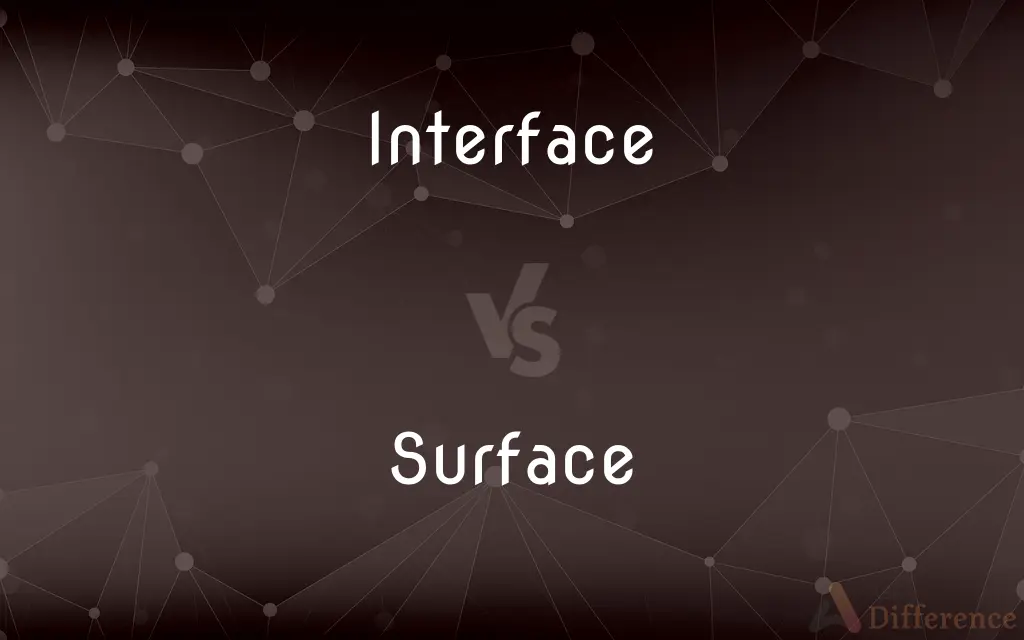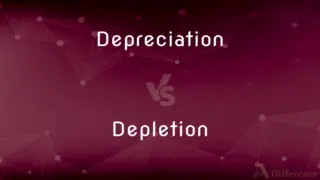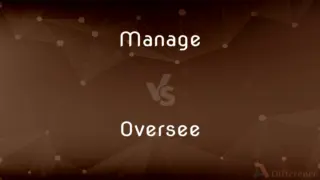Interface vs. Surface — What's the Difference?
By Urooj Arif & Maham Liaqat — Updated on March 28, 2024
An interface is a point of interaction between two systems or entities, often in technology or computing, while a surface is the outermost or uppermost layer of a physical object or space.

Difference Between Interface and Surface
Table of Contents
ADVERTISEMENT
Key Differences
Interfaces allow for communication or interaction between two different systems, components, or users, facilitating exchanges of information or commands. On the other hand, surfaces refer to the external layers or boundaries of objects, which can be perceived through touch or seen, and are fundamental to the physical characteristics of materials.
In computing, an interface might be a software that enables interaction between a computer and a user (like a graphical user interface) or between different software components (like an application programming interface). Conversely, a surface can be as diverse as the touchscreen of a smartphone, the exterior of a vehicle, or the top layer of a table, emphasizing physical properties and interactions.
Interfaces are designed with a focus on usability, compatibility, and communication protocols, aiming to simplify and enhance the interaction between users and systems or between different systems. Surfaces, however, are often discussed in terms of material properties, such as texture, durability, and aesthetics, which impact functionality and user experience.
The effectiveness of an interface is measured by its ease of use, efficiency in facilitating tasks, and how intuitively it can be navigated by the user. Meanwhile, the quality of a surface may be assessed based on its tactile qualities, resistance to environmental factors, and suitability for the intended use or interaction.
While interfaces are critical in determining how users interact with technology, enabling access to digital functionalities and data, surfaces play a crucial role in the physical world, affecting everything from the ergonomics of a device to the visual appeal of an object.
ADVERTISEMENT
Comparison Chart
Definition
Point of interaction between systems, entities, or users.
Outermost or uppermost layer of an object or space.
Primary Context
Technology, computing, and user-system interactions.
Physical properties and characteristics of objects.
Focus
Usability, compatibility, communication protocols.
Material properties, texture, durability, aesthetics.
Evaluation Criteria
Ease of use, efficiency, intuitive navigation.
Tactile qualities, resistance to environmental factors.
Examples
Graphical user interfaces (GUI), application programming interfaces (API).
Touchscreens, the exterior of buildings, skin.
Compare with Definitions
Interface
A medium through which a user interacts with a machine or system.
The smartphone's interface is user-friendly.
Surface
The outer face or layer of an object.
The table's surface was smooth and polished.
Interface
A boundary across which two independent systems meet and act on or communicate with each other.
The API serves as an interface between the application and the operating system.
Surface
The exterior part of a fabric or material.
The fabric's surface was soft to the touch.
Interface
The conceptual boundary where different parts of a system interact.
The interface between the operating system and hardware is crucial for performance.
Surface
In mathematics or physics, a two-dimensional limit of a three-dimensional object.
The surface area of a sphere is calculated based on its radius.
Interface
A physical device or connection between hardware components.
The USB port is an interface for peripheral devices.
Surface
A boundary that defines the limits of a physical object.
The sculpture's surface was intricately carved.
Interface
In software, a set of commands or methods used for interaction with a program.
Developers use the software interface to create apps.
Surface
The part of the Earth's crust covered by water bodies.
The ocean's surface is home to diverse ecosystems.
Interface
A surface forming a common boundary between adjacent regions, bodies, substances, or phases.
Surface
(figurative) Outward or external appearance.
On the surface, the spy looked like a typical businessman.
Interface
A point at which independent systems or diverse groups interact
"the interface between crime and politics where much of our reality is to be found" (Jack Kroll).
Surface
A surface, as the term is most generally used, is the outermost or uppermost layer of a physical object or space. It is the portion or region of the object that can first be perceived by an observer using the senses of sight and touch, and is the portion with which other materials first interact.
Interface
A system of interaction or communication between a computer and another entity such as a printer, another computer, a network, or a human user.
Surface
The outside part or uppermost layer of something
Poor road surfaces
The earth's surface
Interface
A device, such as a cable, network card, monitor, or keyboard, that enables interaction or communication between a computer and another entity.
Surface
A continuous set of points that has length and breadth but no thickness.
Interface
The layout or design of the interactive elements of a computer program, an online service, or an electronic device.
Surface
Relating to or found on the surface of something
Surface layers
Interface
To join by means of an interface.
Surface
Rise or come up to the surface of the water or the ground
He surfaced from his dive
Interface
To serve as an interface for.
Surface
Provide (something, especially a road) with a particular surface
A small path surfaced with terracotta tiles
Interface
To serve as an interface or become interfaced.
Surface
The outer or the topmost boundary of an object.
Interface
Usage Problem To interact or coordinate smoothly
"Theatergoers were lured out of their seats and interfaced with the scenery" (New York Times).
Surface
A material layer constituting such a boundary.
Interface
The point of interconnection or contact between entities.
Public relations firms often serve as the interface between a company and the press.
Surface
The boundary of a three-dimensional figure.
Interface
A thin layer or boundary between different substances or two phases of a single substance.
If water and oil are mixed together, they tend to separate, and at equilibrium they are in different strata with an oil-water interface in between.
The surface of a lake is a water-air interface.
Surface
The two-dimensional locus of points located in three-dimensional space.
Interface
(computing) The point of interconnection between systems or subsystems.
The data is sent over the air interface to the remote system.
Surface
A portion of space having length and breadth but no thickness.
Interface
(computing) The connection between a user and a machine.
The options are selected via the user interface.
Surface
The superficial or external aspect
"a flamboyant, powerful confidence man who lives entirely on the surface of experience" (Frank Conroy).
Interface
The connection between parts of software; also the public or published sections of an object or module,
This interface is implemented by several Java classes.
Traits are somewhat between an interface and a mixin, as an interface contains only method signatures, while a trait includes also the full method definitions; on the other side mixins include method definitions, but they can also carry state through attributes, while traits usually don't.
Surface
An airfoil.
Interface
In object-oriented programming, a piece of code defining a set of operations that other code must implement.
The Audio and Video classes both implement the IPlayable interface.
Surface
Relating to, on, or at a surface
Surface algae in the water.
Interface
(biochemistry) The internal surface of a coiled protein (compare exoface).
Surface
Relating to or occurring on or near the surface of the earth.
Interface
(transitive) To construct an interface for.
Surface
Superficial.
Interface
(ambitransitive) To connect through an interface.
Surface
Apparent as opposed to real.
Interface
(intransitive) To serve as an interface.
Surface
To provide with a surface or apply a surface to
Surface a table with walnut.
Surface a road with asphalt.
Interface
To meet for discussion.
Let's interface on Wednesday.
Surface
To bring to the surface
Surface a submarine.
Interface
A surface forming a common boundary between two things, especially between two fluids.
Surface
To make known; expose or reveal
The first news report that surfaced the allegations.
Interface
Hardware that links one device with another (especially a computer).
Surface
To rise to the surface.
Interface
That part of a computer program which controls the way a program interacts with a user; the manner of inputting and outputting of data, and the way information is presented on a computer monitor; also called user interface; as, a graphical user interface; a character-based interface.
Surface
To emerge after concealment.
Interface
(chemistry) a surface forming a common boundary between two things (two objects or liquids or chemical phases)
Surface
To work or dig a mine at or near the surface of the ground.
Interface
(computer science) a program that controls a display for the user (usually on a computer monitor) and that allows the user to interact with the system
Surface
The overside or up-side of a flat object such as a table, or of a liquid.
Interface
The overlap where two theories or phenomena affect each other or have links with each other;
The interface between chemistry and biology
Surface
The outside hull of a tangible object.
Interface
(computer science) computer circuit consisting of the hardware and associated circuitry that links one device with another (especially a computer and a hard disk drive or other peripherals)
Surface
The locus of an equation (especially one with exactly two degrees of freedom) in a more-than-two-dimensional space. Category:en:Surfaces
Surface
(transitive) To provide something with a surface.
Surface
(transitive) To apply a surface to something.
The crew surfaced the road with bitumen.
Surface
(intransitive) To rise to the surface.
There was great relief when the missing diver finally surfaced.
Surface
(transitive) To bring to the surface.
Surface
To come out of hiding.
Surface
To become known or apparent; to appear or be found.
Surface
(transitive) To make (information or facts) known.
Surface
(intransitive) To work a mine near the surface.
Surface
The exterior part of anything that has length and breadth; one of the limits that bound a solid, esp. the upper face; superficies; the outside; as, the surface of the earth; the surface of a diamond; the surface of the body.
The bright surface of this ethereous mold.
Surface
Hence, outward or external appearance.
Vain and weak understandings, which penetrate no deeper than the surface.
Surface
A magnitude that has length and breadth without thickness; superficies; as, a plane surface; a spherical surface.
Surface
That part of the side which is terminated by the flank prolonged, and the angle of the nearest bastion.
Surface
To give a surface to; especially, to cause to have a smooth or plain surface; to make smooth or plain.
Surface
To work over the surface or soil of, as ground, in hunting for gold.
Surface
To rise from the depths of a liquid to the surface; as, the submarine surfaced to recharge its batteries.
Surface
To become known or public; - said of information.
Surface
To show up, as a person who was in hiding; as, he absconded with the payroll and surfaced in Argentina.
Surface
The outer boundary of an artifact or a material layer constituting or resembling such a boundary;
There is a special cleaner for these surfaces
The cloth had a pattern of red dots on a white surface
Surface
The extended two-dimensional outer boundary of a three-dimensional object;
They skimmed over the surface of the water
A brush small enough to clean every dental surface
The sun has no distinct surface
Surface
The outermost level of the land or sea;
Earthquakes originate far below the surface
Three quarters of the Earth's surface is covered by water
Surface
A superficial aspect as opposed to the real nature of something;
It was not what it appeared to be on the surface
Surface
Information that has become public;
All the reports were out in the open
The facts had been brought to the surface
Surface
A device that provides reactive force when in motion relative to the surrounding air; can lift or control a plane in flight
Surface
Come to the surface
Surface
Put a coat on; cover the surface of; furnish with a surface;
Coat the cake with chocolate
Surface
Appear or become visible; make a showing;
She turned up at the funeral
I hope the list key is going to surface again
Surface
On the surface;
Surface materials of the moon
Subsurface materials of the moon
Surface
Involving a surface only;
Her beauty is only skin-deep
Superficial bruising
A surface wound
Common Curiosities
Can surfaces have interactive properties?
Yes, surfaces can have interactive properties, especially in technology, such as touchscreens, which combine physical and interactive elements.
What is the primary function of an interface?
The primary function of an interface is to enable interaction or communication between different systems, users, and components.
How do interfaces affect user experience?
Interfaces significantly impact user experience by dictating how easily and effectively a user can navigate and use a system or device.
What role do material properties play in the functionality of a surface?
Material properties like texture, durability, and elasticity greatly influence a surface's functionality, aesthetics, and user interaction.
How is the effectiveness of a surface measured?
The effectiveness of a surface is often measured by its suitability for a specific purpose, its durability, and its aesthetic appeal.
What is the significance of a surface's texture?
A surface's texture can influence its visual appeal, tactile experience, and even its functionality, such as grip or friction.
Can the concept of a surface be applied in abstract contexts?
Yes, the concept of a surface can be applied abstractly in areas like mathematics, where it represents a two-dimensional boundary of a three-dimensional figure.
Can an interface also be a surface?
Yes, in cases like touchscreens, the interface (user interaction zone) is also the surface (physical boundary) of the device.
What is the importance of surface treatment in product design?
Surface treatment is crucial for enhancing physical properties, such as resistance to corrosion, aesthetic qualities, and tactile feel.
How do developers ensure compatibility in interfaces?
Developers follow standard protocols and design patterns to ensure compatibility across different devices and systems.
What is the impact of interfaces on accessibility?
Interfaces play a key role in accessibility by enabling people with various disabilities to interact with technology through adaptable design features.
Are interfaces always digital?
No, interfaces can also be physical, such as a keyboard or mouse, allowing interaction between the user and a digital system.
How do interfaces facilitate communication between software components?
Interfaces define a set of rules or methods that allow different software components to interact and exchange data efficiently.
How can the design of an interface influence its usability?
The design of an interface, including its layout, icons, and menus, can greatly influence its usability by making it more intuitive and easier to navigate.
How are new materials influencing the design of surfaces?
Advances in materials science are enabling the creation of surfaces with novel properties, such as self-healing or changeable textures, influencing design and functionality.
Share Your Discovery

Previous Comparison
Depreciation vs. Depletion
Next Comparison
Manage vs. OverseeAuthor Spotlight
Written by
Urooj ArifUrooj is a skilled content writer at Ask Difference, known for her exceptional ability to simplify complex topics into engaging and informative content. With a passion for research and a flair for clear, concise writing, she consistently delivers articles that resonate with our diverse audience.
Co-written by
Maham Liaqat













































